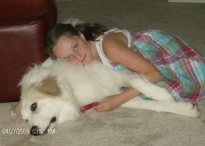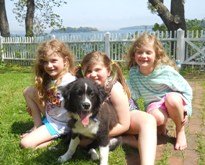|
Fear in DogsFear in dogs is often expressed in several different ways, generally ether by passive behavior such as hiding in a corner or aggressive behavior, lunging at the object that caused the fear. A fearful dog that is barking and lunging after another dog is often afraid and just trying to keep the other dog away. Fear can also cause a dog to dash and hide under the bed. Many behavioral problems stem from fear expressed as aggression. Aggression breeds aggression and nothing feeds aggression like fear both in dogs and humans. Dog’s like humans have a fight-or-flight response to fear. The dog’s response to a scary situation will in part depend on what has worked well in the past. Some dogs will freeze for a few moments before running away or behave aggressively toward the object of fear. A dog that has a stiff still frozen posture is telling you he’s on guard and may choose aggression to deal with his fear. Three Main Causes of Fear in Dogs Shyness The tendency to be fearful around new objects or animals is frequently called shyness, fear of the unfamiliar has been shown to have a high degree of inherited tendencies in dogs. A shy dog may be very friendly with its owner but be fearful of strange people. Socialization Some dogs have not had adequate socialization. Starting as puppies they need to be safely exposed to a wide variety of new people, other dogs, places and animals. Exposing a puppy to an overwhelmed and or traumatic situation will defeat the purpose of socialization resulting in a less confident and frightened pup. Trauma The third reason dogs become fearful is trauma. Although less common than fear caused by a genetic inherited shyness, a traumatic event can create a dog that reacts with fear when a similar situation arises. Body language of an Uncomfortable Dog The Tongue flick is when a dog moves his tongue straight forward out of the mouth and immediately pulled back in. These tongue flicks are either an expression of low level anxiety or submission. Some dog’s do it frequently and others hardly at all. You may see tongue flicks at Vets offices, greeting strange dogs and any other situation that might make them uncomfortable. Becoming aware of this behavior in your or some other dog is useful should the dog be using the tongue flick to say “I’m uncomfortable” You can back off before the dog becomes defensive. Another expression of fear that dogs will exhibited is called whale eye. The anxious dog will turn his head away but keep their eyes on the anxiety provoking object. The whale eye is telling you that the dog is very afraid. Don’t reach out and pet him! A tightly closed mouth can be an indication that the dog is uncomfortable along with the body postures. Check to see how the dog is also holding rest of his body. If he’s stiff and staring directly at you with a tightly closed mouth, that’s a sign of very tense dog. Fear in dogs as well as humans are behind many disturbing behaviors. Fear will most often look like submission or aggression which ever will do the best job at alleviating the fear. We share many common emotions with dogs with fear causing significant suffering for both. Offer your dog the gift of a calm confident being and he in turn may feel that the world is a safer place.
|
Your New Best Friend
Testimonials

Dutchess
I wanted to let you know how well she is doing. She is such a great dog. We love her so much, I can't
Imagine our lives without her!! We are thankful that you had her and we found her with you.
Thank you for sending us the light in our lives!
Pam Thurlow and family

Sox
Hi Susan. Sox is doing great in his new environment. The children love him as you can see in the picture. He is a good boy, and quite the love. He is really smart too. Thanks for the health record. I passed your website along to a few people in Maine already.
Kim-Slade-Brier and Family

Tipsy She is a great little girl, very sweet and naughty just the way I like it. So thank you for doing this work of bringing dogs and people together! The puppy is a delight! She is very sweet and so smart! My kids and husband adore her. In short, she has been a wonderful addition to our family. Thanks Susan! Judy McMahon and family
